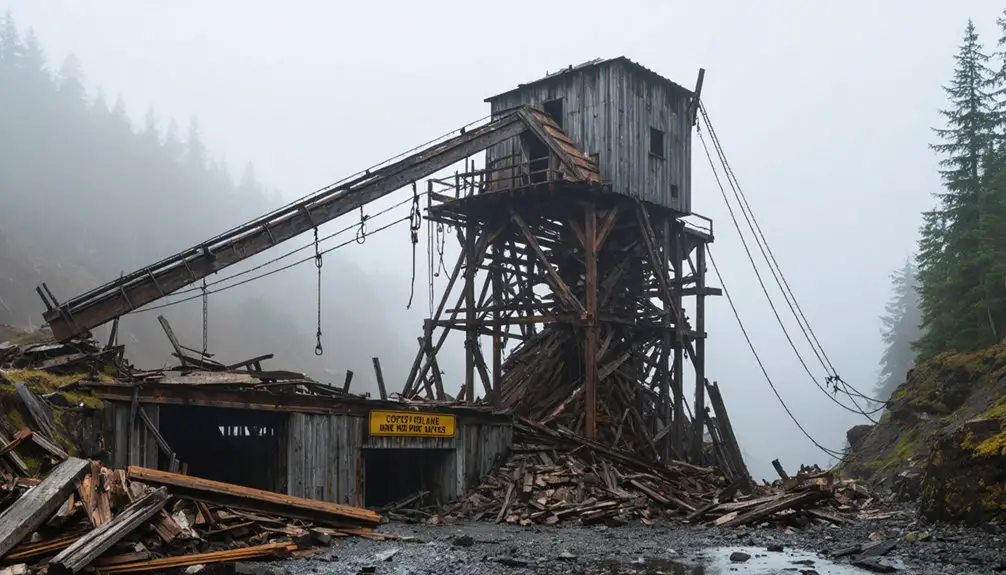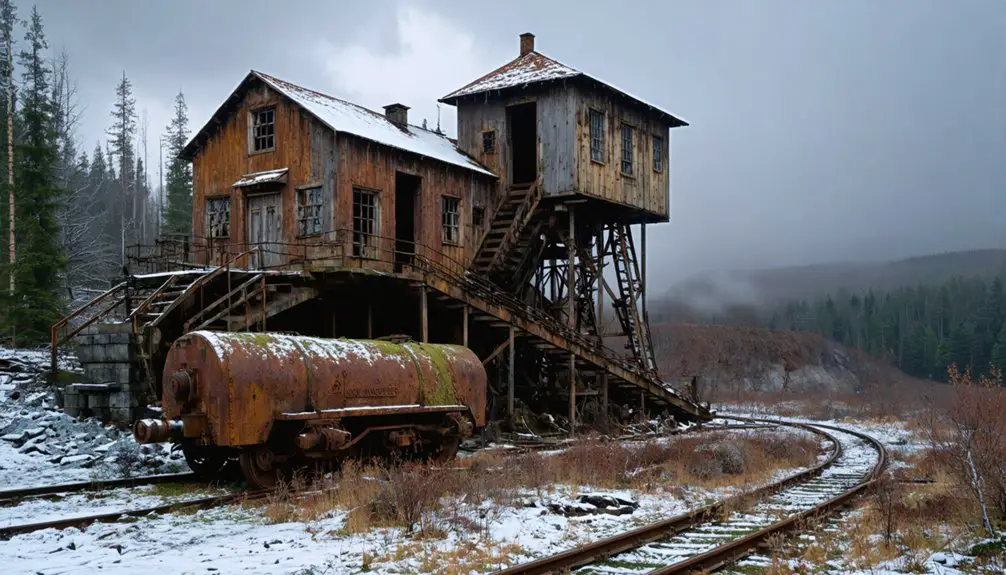You’ll find the historic Copper Falls Mine ghost town perched atop Petherick Hill in Michigan’s Keweenaw Peninsula. From the 1840s until 1901, this industrial mining complex operated seven main shafts and produced nearly 13,000 tons of copper. The site housed immigrant workers from Cornwall, Finland, and Ireland in about 25 homes and two boarding houses. Today, scattered ruins of mine shafts, boarding houses, and offices tell a deeper story of Michigan’s copper mining heritage.
Key Takeaways
- Copper Falls Mine operated from the 1840s until 1901, producing nearly 13,000 tons of copper before becoming a ghost town.
- The mining community featured twenty-five homes and two boarding houses on Petherick Hill, housing immigrant workers from Cornwall, Finland, and Ireland.
- A post office established in 1860 served as the town’s communication hub until operations ceased.
- The site now contains ruins of mine shafts, boarding houses, and offices across its historic 4,000-acre property.
- The ghost town’s remains sit atop Petherick Hill, offering views of the transformed mining landscape in Michigan’s Keweenaw Peninsula.
Historic Origins and Early Settlement
While indigenous peoples had mined copper in Michigan’s Keweenaw Peninsula for over 7,000 years, the establishment of Copper Falls Mine in the 1840s marked the beginning of industrial-scale mining in the region.
The area’s cultural significance dates back to ancient times when native miners extracted surface copper using stone tools, creating trade networks that stretched across the Americas. Early natives fabricated tools and ornaments that have been discovered throughout archaeological sites in the region.
You’ll find the mine’s origins tied to Douglass Houghton‘s influential 1841 survey, which sparked a rush of prospectors to the peninsula.
The site near Owls Creek, chosen for its visible prehistoric mining pits, soon attracted immigrant workers from Cornwall, Finland, and Ireland.
Over its 40-year run until 1901, Copper Falls Mine produced nearly 13,000 tons of ingot copper, transforming indigenous practices into a booming industrial operation. The mine’s significant operations yielded a total of 12,843 tons of refined copper before its closure.
Mining Operations and Technical Developments
Once operations began at Copper Falls Mine in the 1840s, the site quickly developed into a sophisticated industrial complex with seven main shafts exploiting multiple fissure veins.
You’ll find that ore extraction relied on both manual labor and steam-powered machinery, with teams of three miners working together to drill holes and set black powder charges underground.
The miners used a specialized approach called double jacking technique that improved their ability to extract copper from the deposits. A devastating stamp mill fire in 1878 temporarily halted operations and required significant rebuilding efforts.
Life in the Mining Town Community
As the Copper Falls Mine expanded in the 1850s, a vibrant community of immigrant workers settled around the site, establishing approximately twenty-five homes and two boarding houses on Petherick Hill.
You’d find Cornish, Finnish, and Irish families living in modest homes near the mine, sharing their cultural customs and creating strong social bonds. The post office, established in 1860, became an essential communication hub for residents. The area prospered during Michigan’s period as the leading copper producer from 1845 to 1887.
Life centered around the demanding mine work schedule, but you’d witness community gatherings where immigrant traditions came alive through informal social events and religious observances.
Women and children played significant roles in maintaining household stability while men worked long, hazardous shifts underground.
Despite limited amenities and the challenges of frontier living, these close-knit mining families forged a resilient community that endured until the mine’s closure in 1901.
Economic Challenges and Market Forces
You’ll find Copper Falls Mine‘s fortunes closely tied to copper’s dramatic price swings throughout the early 1900s, with the peak of Michigan’s production hitting 266 million pounds in 1916 before crashing during the Great Depression.
Under the management of Capt. James Dunstan, the region demonstrated its potential for profitability, having produced nearly $373,000 worth of minerals in 1880 alone.
The mine experienced multiple cycles of closure and attempted reopening as prices fluctuated, significantly seeing brief resurgence during World War II’s copper demand spike.
When copper prices fell in the post-war period, you’d see most smaller operations like Copper Falls struggle to maintain profitability against rising operational costs and depleting ore quality.
Price Fluctuations Impact Operations
The volatile copper market proved instrumental in shaping the fate of Copper Falls Mine throughout its operational years from the 1840s to 1901.
You’ll find that price volatility forced constant operational adjustments, affecting everything from workforce size to production levels. The mine’s management had to navigate through dramatic market swings that impacted the entire Copper Country region.
When copper prices dropped, you’d see immediate effects on the mine’s ethnic workforce of Cornish, Finnish, and Irish miners. The pressure to maintain profitability during these downturns often led to increased operational risks, as evidenced by the catastrophic mine collapse in 1874.
Like many Michigan copper operations, Copper Falls Mine’s ultimate closure stemmed from its inability to remain profitable amid persistent market instability.
Investment and Reopening Cycles
Despite initial ambitious investments in 1846 for 4,000 acres on Petherick Hill, Copper Falls Mine struggled through numerous financial cycles that defined its operational history.
You’ll find that investment strategies shifted dramatically as the mine battled market forces, with reopening plans constantly adapting to copper price fluctuations and operational setbacks.
- Each catastrophe, from the 1874 cave-in to the devastating 1878 fire, demanded substantial capital for rebuilding.
- Early funding exhaustion forced the first shutdown within just one year of operations.
- Post-disaster resilience kept the mine running for 22 years until 1901, when market prices finally forced permanent closure.
The mine’s story reflects Michigan’s broader copper industry challenges, where survival depended on careful resource management and strategic reinvestment during volatile market conditions.
Notable Accidents and Safety Concerns

While mining operations at Copper Falls proved profitable during Michigan’s copper boom, devastating accidents plagued the site throughout its history, with the worst occurring in 1874 when seven miners were crushed in a catastrophic rock fall.
Like many mines in Michigan’s Copper Country, Copper Falls lacked basic safety protocols during the 19th century. You’d find miners working without protective equipment, facing deadly hazards from rock collapses, shaft falls, and explosive accidents. Research compiled by All Aboard! magazine documented these dangerous working conditions extensively. Falling rock claimed multiple victims, as evidenced by John Ribandi’s death at Tamarack Mine in 1886.
The absence of nearby emergency medical care meant injuries often turned fatal. The mine’s accident statistics reflected the era’s dangerous working conditions, with causes ranging from equipment failures to flooding and gas exposure.
Though safety measures improved by mid-20th century with the introduction of hard hats and headlamps, the inherent risks of underground mining remained a constant threat to workers’ lives.
Immigrant Workers and Cultural Heritage
The Copper Falls Mine’s workforce reflected Michigan’s diverse immigrant heritage, drawing skilled Cornish miners alongside laborers from Croatia, Finland, Ireland, Italy, Slovenia, Hungary, and Poland.
These immigrant communities preserved their cultural identities through ethnic neighborhoods, churches, and mutual aid societies while sharing the dangerous experience of working up to a mile underground in 10-12 hour shifts. Working conditions were extremely hazardous, with one death per week occurring among the mine workers.
You’ll find that many of these workers came through chain migration networks, with Croatian immigrants particularly arriving from Ravna Gora and helping their relatives secure mining jobs. The miners and their families later became involved in the widespread labor unrest that defined the early 1900s American workplace.
Mining Community Demographics
During the height of copper mining activity in Houghton County, immigrants formed a substantial 42.6% of the population by 1900, creating a rich tapestry of cultural diversity. Finnish immigrants led this demographic shift, increasing their presence fivefold to 25.7% of the immigrant population.
You’d find over thirty different language groups in Calumet alone, showcasing remarkable cultural integration.
- Croatian miners from Ravna Gora established strong chain-migration networks, helping fellow countrymen secure mining positions.
- Cornish immigrants dominated mining captain roles, leveraging their extensive underground expertise.
- Finnish communities maintained their cultural identity through newspapers, social clubs, and religious organizations.
Despite facing discrimination, immigrant contributions proved essential to the region’s copper mining success, with immigrant workers filling most underground positions while preserving their unique cultural heritage through mutual aid societies and ethnic organizations.
Worker Skills and Traditions
Immigrant workers took up demanding roles at Copper Falls Mine, bringing diverse skills from Cornwall, Finland, Ireland, Croatia, Italy, Slovenia, Hungary, and Poland.
You’d find these workers enduring grueling 10-12 hour shifts underground, often starting as unskilled laborers pushing trams before advancing to more specialized roles like drilling and blasting.
Worker training happened primarily through apprenticeships and ethnic community networks, where experienced miners passed down crucial safety practices and tool expertise.
Despite harsh conditions, you’ll learn how these immigrants preserved their cultural heritage through vibrant traditions, including religious observances, folk music, and communal celebrations in their ethnic neighborhoods.
They maintained strong cultural identities while developing essential mining skills, creating a rich tapestry of shared knowledge that helped guarantee survival in the dangerous underground world of Copper Falls.
Infrastructure and Town Development
Located near Owls Creek in Michigan’s copper country, Copper Falls Mine emerged in the 1840s with infrastructure that supported both underground operations and surface development.
You’ll find evidence of town layout patterns typical of mid-19th century mining settlements, though infrastructure decay has claimed many original structures. The mine’s steep 27-30 degree shaft required extensive support systems, including ventilation adits and underground rail networks.
- The mine’s heart lay 900 feet underground, where a massive steam hoist powered operations.
- Without modern roads, you’d have relied on Lake Superior’s shipping routes for supplies.
- You can still trace where immigrant workers from Cornwall, Finland, and Ireland built their community.
These elements merged to create a self-sufficient mining town that operated successfully for over four decades.
Legacy and Present-Day Remnants
While Copper Falls Mine ceased operations in 1901, its legacy endures through scattered remnants across Michigan’s Keweenaw Peninsula.
You’ll find ruins of mine shafts, boarding houses, and offices that tell the story of this once-thriving industrial heritage site. The mine’s cultural significance extends beyond its impressive 12,843-ton copper production, representing the diverse immigrant workforce of Cornish, Finnish, and Irish miners who shaped the region.
Beyond crumbling stone and steel, these mining ruins echo the stories of brave immigrants who forged Michigan’s copper legacy.
Today, you can explore the historic 4,000-acre property atop Petherick Hill, where the 700-foot summit offers views of the transformed landscape.
Though time has taken its toll, with structures like the stamp mill lost to fire in 1878, photographers and historians continue documenting these ruins, preserving the memory of Michigan’s copper mining era.
Frequently Asked Questions
What Did Miners Eat During Their Shifts Underground?
You’d find your miner’s diet filled with portable foods during underground meals: Cornish pasties, cured meats, hard cheese, bread, and pickled vegetables – all chosen for durability without refrigeration.
How Much Did Copper Falls Mine Workers Get Paid per Day?
With Michigan’s Copper Country offering higher wages than other US mining camps, you’d have earned between $2.30 and $2.54 per day as a trammer, reflecting the demanding wage history and labor conditions.
Were Children Allowed to Work in the Copper Falls Mine?
While child labor existed in mining before regulations, you won’t find direct evidence of children working at Copper Falls. By the mine’s closure in 1901, labor laws were starting to restrict underage workers.
What Diseases Were Common Among Miners at Copper Falls?
You’d find miners suffering through respiratory diseases from silica dust, musculoskeletal disorders from heavy lifting, toxic exposure illnesses from arsenic, and psychological strain – all common occupational hazards impacting miner health.
Did Any Women Work at the Copper Falls Mine Operations?
You won’t find records of women miners working underground at the mine, but women from mining families played crucial support roles through union activism, household management, and community organization.
References
- https://blogs.mtu.edu/archives/2019/11/01/flashback-friday-mining-history-at-copper-falls-mine/
- https://99wfmk.com/ghost-town-of-copper-falls/
- https://www.keweenawhistory.org/Central-Mining-Co
- https://en.wikipedia.org/wiki/Copper_Falls_mine
- https://www.geni.com/projects/Mine-Fatalities-of-Keweenaw-County/4478047
- https://copperharbor.org/activities-recreation/historic-locations/
- https://en.wikipedia.org/wiki/Copper_mining_in_Michigan
- https://www.youtube.com/watch?v=oxD6hQk0oz8
- https://npshistory.com/publications/kewe/hrs.pdf
- https://www.nps.gov/kewe/learn/historyculture/copper-mining-timeline-page-2.htm



